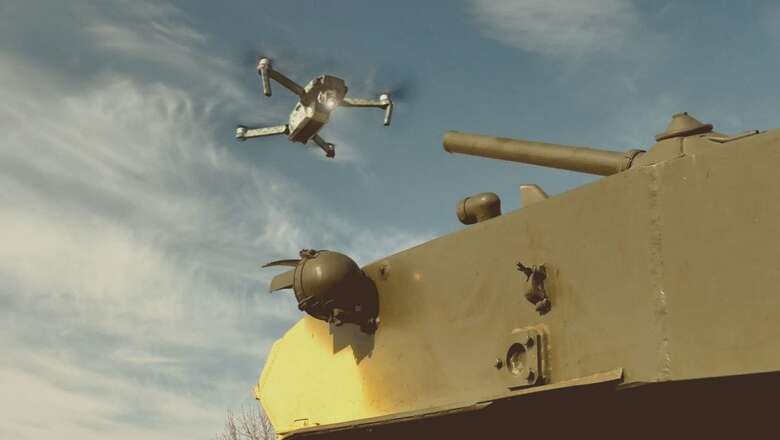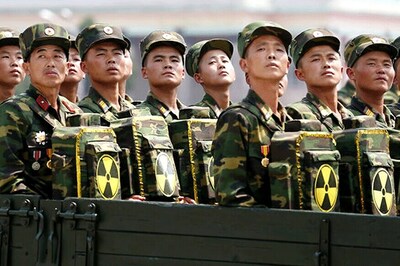
views
The integration of artificial intelligence (AI) into military operations has transformed the landscape of modern warfare. With advancements in machine learning, autonomous devices, and data analysis, AI has become a critical component of 21st-century military strategies. Experts in military strategy are now looking at the role of AI in the military, from cyberattacks to data crunching and autonomous machines, and are now examining the potential implications and future prospects of this technology.
The integration of artificial intelligence into cyber warfare has revolutionised strategic intelligence gathering and provided militaries with unprecedented capabilities. The development of highly sophisticated cyber weapons, empowered by AI, has enabled military agencies to infiltrate and sabotage critical infrastructure with precision and effectiveness. The Stuxnet virus, infamous for its targeted attack on Iranian centrifuges, exemplifies the potential of AI in cyber warfare. Since then, AI-driven viruses have evolved to not only disrupt but also gather valuable strategic information, offering insights that were previously inaccessible.
The collection and analysis of vast amounts of data have been facilitated by AI-powered algorithms, transforming the landscape of intelligence gathering. Satellite surveillance, battlefield sensors, and cyber operations generate massive datasets that are processed using learning algorithms. These algorithms possess the ability to decipher complex patterns, uncover hidden relationships, and extract actionable intelligence from the data. By leveraging AI, military agencies can gain critical insights into adversary capabilities, intentions, and vulnerabilities, facilitating informed decision-making and proactive responses.
Beyond the Stuxnet virus, numerous other examples highlight the impact of AI in cyber warfare and strategic intelligence. For instance, AI algorithms have been utilised to detect and analyse patterns of malicious activities in network traffic, enabling the identification and mitigation of cyber threats. Machine learning algorithms can also be employed to monitor social media platforms and other online channels, extracting valuable information about potential adversaries or monitoring public sentiment during conflicts.
Furthermore, AI-powered systems can augment traditional surveillance methods, enhancing the collection and analysis of intelligence in real time. Sophisticated satellite systems equipped with AI algorithms can process vast amounts of imagery data, identify patterns, detect anomalies, and track movements on the ground. This enables military agencies to monitor regions of interest, track potential threats, and gain valuable situational awareness.
As AI continues to advance, it holds the potential to transform strategic intelligence gathering even further. For instance, natural language processing algorithms combined with AI can analyse vast amounts of textual information, such as intercepted communications or open-source intelligence, providing insights into enemy plans, intentions, and networks. Similarly, AI algorithms can be employed to analyse and detect patterns in financial transactions, enabling the identification of illicit funding sources supporting hostile activities.
The utilisation of AI algorithms for data crunching and decision-making has transformed military operations, allowing analysts to effectively navigate through vast amounts of information. These algorithms, akin to those employed by industry giants like Amazon, possess the capacity to process and extract patterns from extensive datasets. Remarkably, AI algorithms have exhibited decision-making prowess that surpasses human capabilities in specific domains. The victory of the AlphaGo program against a human grandmaster in the intricate ‘Game of Go’ serves as a prime example, showcasing AI’s capacity to make unexpectedly bold moves that catch opponents off guard.
In the military realm, AI-driven mass surveillance and counterinsurgency operations have yielded remarkable results, empowering real-time analysis of imagery captured by CCTV cameras and drones. This capability enables military agencies to efficiently monitor and track multiple potential targets, a task that would have been inconceivable without the aid of AI. The integration of AI algorithms with surveillance systems allows for the swift processing and interpretation of visual data, facilitating enhanced targeting and rapid response capabilities. The ability to analyse vast amounts of imagery data enables military analysts to detect potential threats, identify suspicious activities, and gain valuable situational awareness.
Moreover, AI algorithms have demonstrated their utility in enhancing decision-making processes within military operations. By processing and analysing extensive datasets, these algorithms can identify trends, correlations, and insights that human analysts might overlook. For instance, AI algorithms can be employed to analyse historical military data, identify patterns of enemy tactics, and predict their future moves. This empowers military decision-makers with valuable information to formulate effective strategies and responses.
The impact of AI algorithms on decision-making extends beyond the battlefield. Military logistics and resource allocation can also benefit from the data-driven capabilities of AI. By analysing supply chain data, AI algorithms can optimise resource distribution, anticipate maintenance needs, and streamline operations. This ultimately enhances the efficiency and effectiveness of military logistics, ensuring that resources are allocated in the most optimal manner.
Autonomous machines have emerged as a significant area of focus within military AI, offering a glimpse into the future of warfare. As the capabilities of AI continue to advance, the development of autonomous systems has gained momentum, aiming to minimise the reliance on human intervention. While human decision-making is currently preferred, the inherent vulnerability of communication links during wartime has spurred the exploration of autonomous technologies. Unmanned aerial vehicles (UAVs) like the Global Hawk exemplify the potential of autonomous machines in military operations. These UAVs can execute missions independently, eliminating the need for constant reliance on data links and enhancing their survivability in hostile environments.
Governments across the globe recognise the strategic importance of autonomous systems and are actively investing in their development. France’s Dassault nEUROn and Russia’s Sukhoi S-70 serve as prime examples of cutting-edge autonomous platforms. These advanced systems have the capacity to execute complex missions with minimal human oversight, marking a paradigm shift in military capabilities. Collaborative efforts between countries, such as Australia’s collaboration with Boeing to create the “loyal wingman” demonstrate the potential of AI as a force multiplier alongside human pilots. The “loyal wingman” concept envisions an unmanned aircraft operating in tandem with a manned aircraft, providing support, defence, and completing missions either independently or in coordination with the human pilot. This collaborative approach not only enhances operational efficiency but also acts as an AI bodyguard, safeguarding the human pilot while sacrificing itself if necessary.
These examples underscore the growing trend towards autonomous machines in military applications. By combining the power of AI with advanced technologies, autonomous systems have the potential to revolutionise warfare. Their ability to operate independently and adapt to dynamic situations offers advantages such as increased agility, precision, and endurance on the battlefield. However, the deployment of autonomous combatants, commonly referred to as “killer robots,” poses ethical concerns and necessitates the establishment of robust guidelines to ensure responsible and accountable use.
Ethical Concerns and Future Implications
The deployment of autonomous combatants, often referred to as “killer robots,” raises ethical concerns and necessitates the development of codes of ethics for their use. While such combatants are yet to be realised, the ongoing development of AI in military applications warrants careful consideration of the potential consequences. As each facet of AI in the military advances, the potential of other systems also increases, creating a paradigm shift in warfare. Although we may not be facing Terminator-like scenarios depicted in science fiction, the convergence of AI and military capabilities could transform future conflicts.
Conclusion
Artificial intelligence has emerged as a game-changing technology in modern military operations. From cyber warfare to data analysis and the development of autonomous systems, AI enhances the accuracy, precision, and efficiency of military endeavours. However, ethical concerns surrounding autonomous combatants highlight the need for responsible and carefully regulated implementation. As AI continues to evolve, the line between science fiction and reality in warfare becomes increasingly blurred. It is crucial for policymakers, military strategists, and society as a whole to navigate this new era of AI in the military with nuanced understanding and thoughtful consideration.
Amitabh Singh is an Associate Professor at the School of International Studies, JNU; Vivek Pandey is a PhD Scholar at the School of International Studies, JNU. Views expressed are personal.




















Comments
0 comment